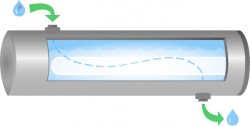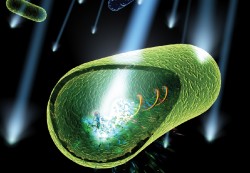
How Does UV Disinfection Work?
The ultraviolet (UV) treatment process is an extremely quick physical process. Ultraviolet light mutates and/or degrades DNA. DNA (or deoxyribonucleic acid) is the part of the cell that gives an organism its instructions on how to function and reproduce.
When the DNA is damaged, the organism becomes unable to function because its “instructions” are garbled or missing. An organism that has no instructions cannot function and reproduce, and cannot cause infection. It is rendered harmless and eventually dies.
 In the UV disinfection process, water is purified as it runs through a stainless steel chamber (also called a “reactor”) that contains a special UV- producing lamp. As the water flows past the lamp, the microbes in the water receive a lethal dose of UV.
In the UV disinfection process, water is purified as it runs through a stainless steel chamber (also called a “reactor”) that contains a special UV- producing lamp. As the water flows past the lamp, the microbes in the water receive a lethal dose of UV.
The water is then safe to drink. However, different organisms require different levels of UV energy to disrupt their DNA. This energy level is known as a UV dose.
How Do You Calculate UV Dose?
UV Dose is expressed in mWs/cm2 or mJ/cm2. The accepted standard for most applications is 30 mJ/cm2. A slower flow rate will result in a higher UV dose. The longer the chamber and the longer the water stays in contact with the UV lamp, the higher the dose. Most UV manufacturers have a variety of systems suitable for different dose requirement
Intensity is the quantity of UV light per unit area, and time is the amount of “contact time:” the water spends in the chamber.
UV dose is determined by calculating two amounts: UV light intensity and time.
Depending on the type of microorganism you are dealing with, your system needs will be different. Consult a water treatment professional to ensure that you are getting the right kind of system for your needs.
Factors That Affect UV Dose
Different factors can affect UV dose and the ability of UV to deactivate organisms in the water. If there is turbidity (large amounts of particles) or water hardness, microorganisms can “hide” behind these particles. This hampers UVT, or UV transmittance, the amount of UV that actually penetrates the water. With a low UVT, “hidden” microorganisms will not receive the required dose of UV light to deactivate their DNA, and the water will not be properly disinfected.
Performing a water test will indicate what type of pre-treatment a UV system requires to increase UVT and produce maximum effective disinfection. The following chart shows the ideal state for maximum results:
| Parameter | Influence / Effect | Limits |
|---|---|---|
| UV Transmittance | Measure of absorption of UV light, UVT can affect system sizing requirements | > 75% UVT @ 254nm |
| Iron | Can affect both UVT and sleeve fouling | < 0.3 ppm (0.3 mg/L) |
| Hardness | Can cause sleeve fouling | < 120 ppm (7 gpg) |
| Turbidity | Can shield pathogen, post UV contamination | < 1 NTU |
| Tannins | Can affect UVT and system performance | < 0.1 ppm (0.1 mg/L) |
For NSF 55 Class A requirements (which may apply where you live, check with your local municipal health region), UV dose is required to be 40 mJ/cm2. If you aren’t sure if you are required to use an NSF-certified system for regulatory requirements in your area, ask your local water treatment professional.
They should be able to inform you about any laws or regulations that regulate water treatment equipment where you live.